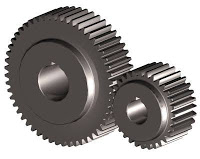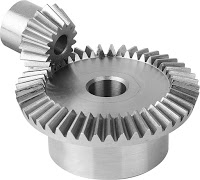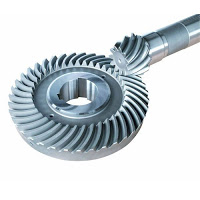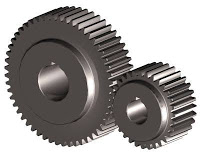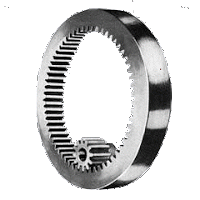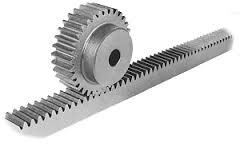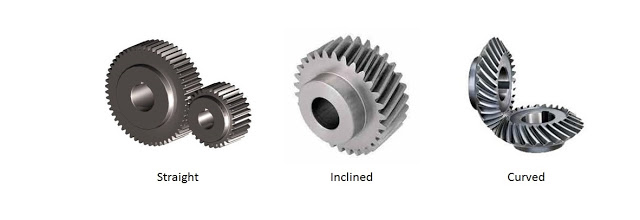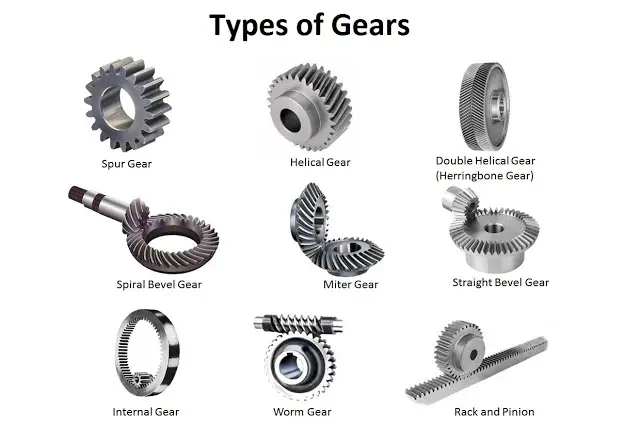In this article, we will learn about different types of gears used to transmit powers from one shaft to another. The various gear types obtained on the basis of different criteria are spur gear, helical gear, spiral gear, bevel gear, rack, and pinion, etc. Here we will discuss each type in brief. Gears are basically used to transmit powers from one shaft to another.The classification of the gears is done on the following basis:
1. On the Basis of Arrangement of Shafts of Gears
(i) Parallel Gears
When two parallel and coplanar shafts are connected by gears as shown in the figure above, the types of gears used are called as spur gears. The arrangement of gears is called spur gearing. Spur gears have teeth parallel to the axis of the wheel.
Examples: Spur gear, helical gear, double helical gear (herringbone gear)
(ii) Intersecting Gears
When two non-parallel or intersecting but coplanar shafts are connected by the gears as shown in the figure given above is called bevel gears. And such an arrangement is called as bevel gearing.
Examples: Bevel gear, helical bevel gear, miter gear.
(iii) Non-Intersecting and Non-Parallel
When non-intersecting and non-parallel i.e. non-coplanar shafts are connected by gears as shown in the figure given above is called skew bevel gears or spiral gears. And the arrangement is called skew bevel gearing or spiral gearing.
Examples: Spiral gears.
2. On the Basis of the Peripheral Velocity of the Gears
(i) Low Velocity:
(ii) Medium Velocity:
The gears which have velocity in between 3 m/s and 15 m/s are called medium velocity gears.
(iii) High Velocity:
The gears which possess velocity more than 15 m/s are called as high-velocity gears.
Also Read:
- What is Slotter Machine?
- What is Gear Ratio in Transmission System?
- What is Lathe Machine? Main parts, Operations and Working
3. On the Basis of the Types of Gearing.
(i) External Gearing
When gears of two shafts mesh externally as shown in the figure given above, then the gears are called as external gears. In external gearing the larger of the two meshed gears is called spur or gear and the smaller is called a pinion. The motion of the two wheels in external gearing is always unlike (i.e. if one moves clockwise than other will move in anticlockwise direction).
(ii) Internal Gearing
When the gears of the two shafts mesh internally with each other as shown in the figure given above then it is called internal gearing. In internal gearing the larger of the two wheels is called an annular wheel and the smaller wheel is called a pinion. The motion of the two wheels in the internal gearing is always like (i.e. if one moves clockwise than the other will also move in the clockwise direction).
(iii) Rack and Pinion
Sometimes what happens, the gears of a shaft meshes externally and internally with the gears in strait line (i.e. strait line is also defined as the wheel of infinite radius). Such type of gear is known as rack and pinion. In rack and pinion types of gears, the straight line gear is called rack and the circular gear is called pinion. Rack and pinion gears are used to convert linear motion into rotary motion and vice-versa.
4. On the Basis of the Position of Teeth on the Gear.
(i) Straight
Straight gears have straight teeth on the surface of the wheel rim. For example Spur gear.
(ii) Inclined
The inclined gears have inclined teeth on the surface of the wheel rim. For example: Helical gears.
(iii) Curved
Curved gears have curved teeth on the surface of the wheel. For example: Spiral gears.
Types of Gears
- Types of Milling Cutters Used in Machining Process
- What is Milling Machine – Operation, Parts and Types.
- What is CNC Machine – Main Parts, Working, Block Diagram
Now we will discuss each classification of gears one by one in detail.
1. Spur gear
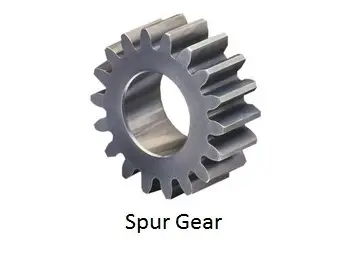
the spur gear is the simplest gear among all types of gears and easy to manufacture. It has straight teeth parallel to the axis of the wheel or shaft. It is used to transmit power between parallel shafts. Only one tooth of the spur gear meshes at a time. It is regularly used for speed reduction or increase, resolution and accuracy enhancement for positioning systems, torque multiplication. It creates noise during its operation.
2. Helical Gears
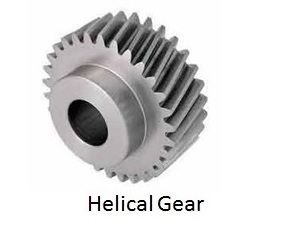
The helical gears have inclined teeth (teeth cut at an angle to the face of the gear) on the surface of the wheel. Its operation is smoother and quieter as compared with the spur gear. It is mostly commonly used in transmission gearboxes.
Helical gear can be further sub divided into two types
(i) Single Helical Gears
It is gear that has an inclined tooth on its wheel surface. Single helical gear possesses axial thrust.
(ii) Double Helical Gears or Herringbone Hears
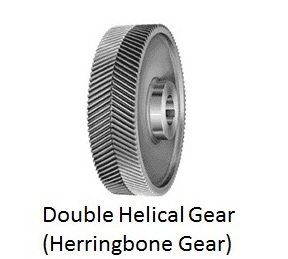
Herringbone gear is a type of double helical gear in which there is side to side combination of two helical gears of opposite hands. If we look from the top than each helical groove on this gear looks like a V letter. The herringbone or double helical gears have zero axial thrusts which is not so with the single helical gear. Unlike helical gears, it has the advantage of transmitting power smoothly because it meshes two teeth at a time.
3. Bevel Gears
These are the gears that transfer powers between two non-parallel or intersecting shafts. These types of gears are most commonly used in the differentials drive of an automobile.
The bevel gear are further classified as
(i) Straight Bevel Gear
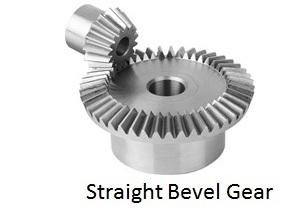
This gear has straight teeth, conical pitch surface, and tapering towards apex.
(ii) Skew Bevel Gears or Spiral Bevel Gear
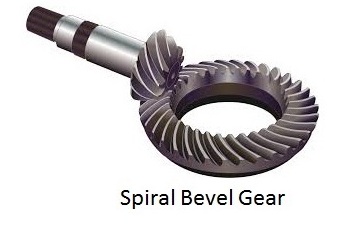
This has curved teeth at an angle that allows gradual and smooth contact of the tooth.
(iii) Zerol Bevel Gear
These gears are similar to the bevel gear but it has curved teeth with a spiral angle of zero, so the ends of the tooth align with the axis.
(iv) Hypoid Bevel Gear
These types of gears are similar to the spiral bevel gear but the pitch surface is hyperbolic and not conical.
(v) Miter Gear
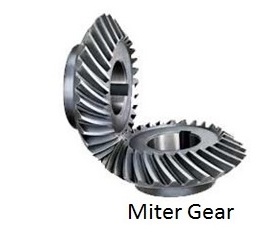
It is a type of bevel gear in which the two shafts intersect at right angles with each other. It is used to transmit powers at right angles.
4. Internal Gearing
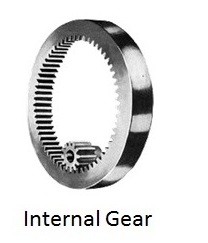
In internal gearing, the two gears are meshed internally with each other.
5. External Gearing
In external gearing, the two shafts are connected with the gears that mesh with each other externally.
6. Rack and Pinion Gears
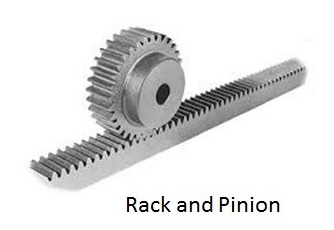
In rack and pinion gears, a shaft meshes externally and internally with a straight line gear. The circular gear is called as pinion and the straight line gear is called a rack. The rack and pinion gear is shown in the figure given below.
7. Worm Gear
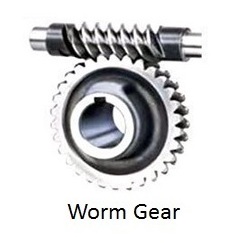
A worm gear is an arrangement of two gears in which one gear is called as worm ( gear in the form of a screw) meshes with a worm gear ( similar as spur gear). The two elements are called as worm screw and worm wheel. Worm gears are used in presses, rolling mills, on rudders and worm drive saws etc.
This is all about the types of gears used in power transmission from one shaft to another. If you have any queries about this then comment us. And if you found this article informative and useful than share and like us.

